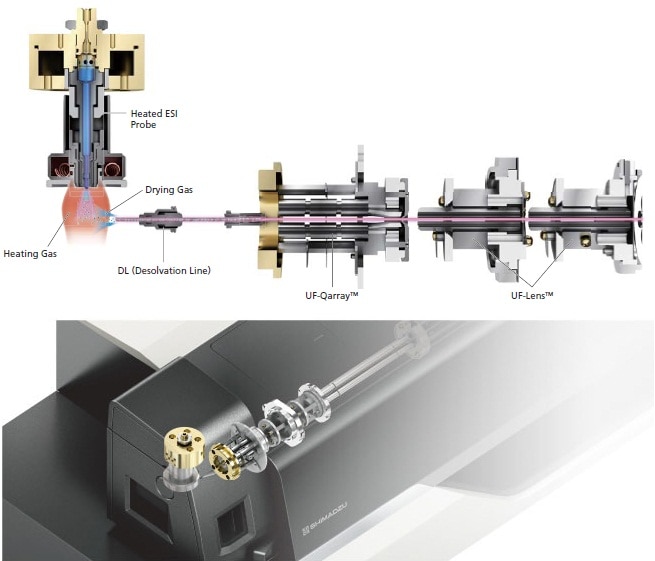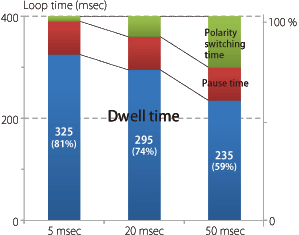LCMS-8060 - Особенности
High Performance Liquid Chromatograph Triple Quadrupole Mass Spectrometer
Sensitivity
By redefining the ion focusing capability on the UF-Qarray, the LCMS-8060 brings a meaningful impact to quantitative detection and opens new opportunities for scientists to deliver solutions that make a true difference.
The newly developed UF-Qarray ion guide is a groundbreaking technology that increases LC/MS/MS sensitivity by enhancing ion signal intensity and reducing noise. By improving the ion sampling device, the ion guide, and the vacuum efficiency, the LCMS-8060 delivers a new vision of sensitivity and makes a real difference to working better and faster.


MRM chromatograms : 100 ng/mL neat standard, upper : signal comparison, lower : baseline noise comparison
Built on the proven platform of the LCMS-8050, the new patented ion guides developed for the LCMS-8060 greatly improves ion production and collisional focusing without affecting noise.
The ion production, transmission and detection of three pesticides (fenoxaprop-ethyl, clofentezine and triclopyr) results in increased sensitivity compared to previous technologies.

The chromatogram for each pesticide has been magnified to show the noise has not increased with a higher ion production.
Innovations in ion guide technologies not only delivers new limits of MRM sensitivity but has an impact on full-scan sensitivity.

Comparison between the LCMS-8060 (purple) and LCMS-8050 (blue) for the analysis of lipids
(precursor ion scanning at m/z 184-choline-containing phospholipids in positive ion mode)
Lipid profiling on the LCMS-8060 can detect more ion signals with greater precision and with higher confidence. After protein precipitation, the human serum sample was diluted 1000 times by methanol and 1uL was injected onto the LCMS-8050 and LCMS-8060 systems using a scan speed of 3,000 u/sec. With the LCMS-8060 lower levels of phosphatidylcholine could be detected in a human serum sample following a protein crash sample preparation compared to the LCMS-8050.
Speed
Inspired by the need to balance advanced high speed MS/MS detection technologies with unrivalled LC performance, we were the first mass spectrometry company in the world to deliver a scan speed of 15,000 u/sec and a polarity switching speed of 15 msec. In the LCMS-8060 the scan speed is now increased to 30,000 u/sec and a polarity switching speed of 5 msec making a real difference to working better and faster.
Fast polarity switching
The LCMS-8060 uses UF Technologies to switch polarity in 5 msec.
Detect more
Fast cycle time helps to detect more compounds with greater confidence and precision.
Faster polarity switching time maximizes dwell times and helps to optimize the cycle time of LC/MS/MS methods.

Comparing the differed polarity switching times from 5, 20 to 50 msec. Ratio of dwell time (blue), pause time (red) and polarity switching time (green) in 400 msec of loop time when 65 of MRMs are simultaneously monitored.

MRM chromatograms of 105 pesticides (300 pg/mL each) using a polarity switching speed of 5 msec
and a sampling window of 65 compounds in 400 msec loop time
Solutions
Solving Complex Problems

High-sensitivity quantitation of intact catecholamines (CAs) in human plasma.
In clinical research, plasma catecholamines and their O-methylated metabolites (metanephrines) are measured as biomarkers for diseases such as hypertension, pheochromocytoma or neuroblastoma.
It is a challenging assay as the low physiological levels of CAs, physicochemical properties, and potential interferences require high sensitivity and specificity.
We developed a SPE-LC/MS/MS assay by using LCMS-8060 to detect catecholamines at ultra-high sensitivity without matrix interferences. As the measurement cycle time was 12 mins including the column re-equilibration the LCMS-8060 assay opens new possibilities for multiplexed sample analysis and higher sample throughput.


Detection of Norepinephrine, Epinephrine and Dopamine and their deuterated internal standards in plasma
Stability
Long term stability study on LCMS-8060
The robustness of the LCMS-8060 and modified ion optics was also assessed by injecting 2400 samples of femto-gram levels of alprazolam spiked into protein-precipitated human plasma extracts over a 6 day period (over 400 samples were injected each day). The RSD of peak area response was 5% over this test period, using a deuterated internal standard (alprazolam-d5) the RSD was 3.5%. As part of the robustness test the vacuum system was vented to model a transient power failure with no effect on signal response or baseline noise level.


MRM chromatograms for the 1st, 1200th and 2400th measurements of alprazolam
| Compound | Intra-Day Variation (%RSD) | Inter-Day Variation (%) | |||||||
| 1st day | 2nd day | 3rd day | 4th day | 5th day | 6th day | Days 1-3 |
Days 4-6 |
6 Day Total |
|
| Alprazolam | 5.04 | 4.94 | 5.06 | 5.38 | 4.55 | 4.83 | 3.19 | 1.63 | 2.74 |
| Alprazolam-d5 (ISTD) | 5.04 | 4.68 | 5.48 | 5.31 | 4.26 | 4.91 | 2.62 | 1.89 | 2.18 |
| Area ratio(Alprazolam / Alprazolam-d5) | 3.48 | 3.11 | 3.48 | 3.44 | 3.71 | 3.54 | 1.79 | 0.26 | 1.40 |
Easy System Maintenance Reduces Downtime
As with Shimadzu’s other triple quad systems, maintaining the LCMS-8060 is simple. Replacing the desolvation line (DL) and ESI capillary is quick and easy. Additionally, the design allows users to replace the DL without breaking vacuum, providing greater uptime and usability.
Steps for DL Replacement



